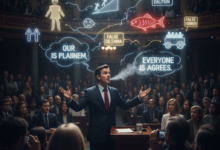Emotional Intelligence: Why It Matters and How to Develop It

Understanding Emotional Intelligence
Emotional Intelligence (EI) refers to the ability to recognize, understand, and manage our own emotions as well as the emotions of others. This concept has gained significant traction in recent years, emphasizing its value in various aspects of our lives. The core components of EI can be summarized into five key areas: self-awareness, self-regulation, motivation, empathy, and social skills.
Self-awareness is the foundation of emotional intelligence. It involves recognizing one’s own emotional states and understanding how these emotions can affect thoughts and behavior. Individuals with high self-awareness are often more in tune with their feelings, leading to better decision-making and interpersonal relationships.
Following self-awareness is self-regulation, which allows individuals to manage their emotions and impulses effectively. This component enables one to control emotional responses, even in stressful situations, fostering a sense of resilience. Self-regulated individuals are adept at staying calm and collected, facilitating a more thoughtful response rather than reacting impulsively.
Motivation, the third element, pertains to one’s intrinsic drive to pursue goals with energy and persistence. Emotionally intelligent individuals are usually motivated by their values and objectives, rather than external rewards, which aids in their overall performance and satisfaction.
Empathy, the fourth component, involves the ability to understand and share the feelings of others. This skill is crucial for building strong relationships, as it allows for deeper connections and greater compassion. Lastly, social skills encapsulate the ability to interact harmoniously with others. Those possessing strong social skills can effectively navigate social complexities, inspire others, and create healthful networks.
Understanding these components provides a framework for recognizing how emotional intelligence influences both personal well-being and professional success. By fostering EI, individuals can enhance their communication, improve teamwork, and navigate challenging situations with greater ease.
The Importance of Emotional Intelligence
Emotional Intelligence (EI) is a critical factor that influences various aspects of daily life, significantly shaping how individuals interact with others and manage their own emotions. Research has shown that individuals with high levels of emotional intelligence are better equipped to navigate social complexities, fostering healthier relationships and improving communication. This ability to recognize, understand, and manage emotions not only aids in personal interactions but also plays a vital role in professional environments where teamwork and collaboration are essential.
In matters of mental health, emotional intelligence can serve as a buffer against stress and anxiety. Studies indicate that individuals possessing greater emotional awareness and regulation can better cope with adversity, thereby enhancing their overall well-being. By recognizing triggers and understanding emotional responses, people with high EI can employ strategies that mitigate negative feelings, leading to improved mental resilience.
Moreover, effective decision-making is closely linked to emotional intelligence. When individuals can identify and process their emotions, they are more likely to make informed and rational choices rather than impulsive ones driven by heightened emotional states. This skill can lead to more favorable outcomes in both personal and professional scenarios, emphasizing the importance of EI as a crucial tool for success.
Career advancement is another area where emotional intelligence proves beneficial. Employers often value EI in potential hires, recognizing that individuals with strong interpersonal skills contribute positively to workplace culture and productivity. According to various experts in organizational psychology, employees who exhibit high levels of emotional intelligence often demonstrate better leadership capabilities and adaptability, further enhancing their professional growth.
In summary, emotional intelligence is an essential attribute that impacts relationships, mental health, decision-making, and career success. Recognizing its significance underscores the need to develop and cultivate emotional intelligence in both personal and professional spheres for a well-rounded and fulfilling life.
Emotional Intelligence vs. IQ: Understanding the Difference
Emotional Intelligence (EI) and Intelligence Quotient (IQ) are two concepts often related to human capability, yet they represent distinct dimensions of human functioning. While IQ is a measurement of cognitive abilities, including reasoning, problem-solving, and analytical skills, emotional intelligence pertains to the recognition, understanding, and management of emotions—both one’s own and those of others. This distinction is paramount; it emphasizes the multifaceted nature of human intelligence beyond traditional cognitive measures.
IQ tests typically assess logical-mathematical and linguistic intelligences, providing a numerical representation of an individual’s intellectual potential. However, this type of intelligence alone cannot predict a person’s ability to navigate social complexities, manage stress, or establish empathy. In stark contrast, emotional intelligence encompasses skills such as emotional awareness, empathy, self-regulation, and interpersonal communication. These competencies contribute significantly to personal and professional success, often outperforming traditional IQ metrics in real-world applications.
Individuals with high emotional intelligence tend to excel in environments that require teamwork, leadership, and conflict resolution. They can assess emotional cues and create a positive atmosphere, thus promoting collaboration and understanding. Furthermore, research has shown that EI is closely linked to mental health; people with heightened emotional awareness often experience less anxiety and depression, and they maintain better relationships. In this sense, both emotional intelligence and IQ play vital roles in a person’s overall well-being and success, yet the former equips people with essential social and emotional skills needed to thrive in everyday interactions.
To summarize, while IQ gives an insight into cognitive capabilities, emotional intelligence encompasses a broader spectrum of human potential that focuses on emotional and social skills. Understanding the difference between these two types of intelligence will allow individuals to recognize the importance of developing their emotional competencies alongside their cognitive abilities, creating a more holistic approach to personal development.
The Benefits of Developing Emotional Intelligence
Emotional intelligence (EI) encompasses the ability to recognize, understand, and manage one’s emotions as well as the emotions of others. Developing emotional intelligence provides a multitude of benefits that can significantly enhance both personal and professional relationships. One of the foremost advantages of improved emotional intelligence is the enhancement of communication skills. Individuals with high EI can articulate their thoughts and feelings more effectively, leading to clearer and more constructive conversations. This proficiency not only helps in reducing misunderstandings but also fosters stronger interpersonal connections.
Moreover, individuals with elevated emotional intelligence are better equipped to handle conflict. They can navigate challenging situations with empathy and patience, allowing for more amicable resolutions. This ability to resolve conflicts peacefully is invaluable in both workplace environments and personal relations, as it contributes to a more harmonious atmosphere and encourages collaboration among peers. In many cases, high EI is synonymous with exceptional leadership qualities. Leaders who possess emotional intelligence can inspire and motivate their teams, foster a supportive work environment, and enhance employee engagement. Such leaders are often seen as approachable and are able to guide their teams through challenges effectively.
Additionally, developing emotional intelligence has profound implications for mental health resilience. Emotionally intelligent individuals can better manage stress and practice self-care, which is critical in today’s fast-paced world. By understanding their emotional triggers, they can adopt strategies to mitigate anxiety and cultivate a more balanced emotional state. This awareness not only promotes mental well-being but also lays the foundation for a fulfilling life. Ultimately, the benefits of emotional intelligence extend beyond individual improvement; they pave the way for healthier relationships, effective teamwork, and overall enhanced quality of life.
Assessing Your Emotional Intelligence Level
Understanding one’s emotional intelligence (EI) is a critical step towards personal and professional growth. To effectively assess your emotional intelligence level, you can utilize various tools and practices designed to provide insights into your emotional awareness, regulation, and empathy. This assessment can illuminate strengths and pinpoint areas that require enhancement.
One popular method of assessing emotional intelligence is through standardized assessment tools. Numerous online platforms offer reliable EI quizzes, where users respond to scenarios related to emotional awareness, social skills, and relationship management. Tools like the Emotional Quotient Inventory (EQ-i) and the Schutte Self-Report Emotional Intelligence Test (SSEIT) are well-researched and widely recognized, providing a comprehensive overview of individuals’ emotional competencies. These tools often consist of multiple-choice questions that yield scores indicative of one’s emotional intelligence level.
In addition to formal assessments, self-reflective exercises can offer valuable insights. Maintaining a journal to document instances where emotions influenced your reactions can be profoundly revealing. Reflecting on moments of conflict or collaboration enables you to evaluate your emotional responses and assess your ability to empathize with others. Questions to consider include: How do I respond to stressful situations? Am I aware of how my emotions affect my behavior and decisions? What are my coping strategies in times of emotional upheaval?
Another effective self-assessment practice involves seeking feedback from trusted colleagues or friends. Engaging in honest conversations with others about your emotional interactions can help highlight perceived strengths and weaknesses in your emotional responses. Their perspectives on your interpersonal skills may uncover blind spots that you may not recognize on your own.
By utilizing these tools and exercises for self-evaluation, you can gain a clearer understanding of your emotional intelligence level. This assessment serves as a foundation for further development, allowing you to enhance your capabilities and foster better relationships in both personal and professional spheres.
Strategies for Improving Emotional Intelligence
Enhancing emotional intelligence (EI) is a vital endeavor, as it plays a significant role in personal and professional success. Several strategies can be employed to foster emotional intelligence effectively. One of the most recommended practices is mindfulness. Mindfulness involves being present and fully engaged in the moment, which can improve self-awareness and help individuals recognize their emotional responses. Regular mindfulness meditation fosters a greater understanding of one’s thoughts and feelings, allowing for better emotional regulation and response to stressors.
Another fundamental approach to improving emotional intelligence is through empathy exercises. Empathy is the ability to understand and share the feelings of others, and practicing this skill can be transformational. Engaging in active listening during conversations, where one focuses entirely on the speaker without interrupting, can enhance empathy. Additionally, trying to view situations from another person’s perspective can deepen emotional understanding and strengthen interpersonal connections.
Furthermore, developing effective communication skills is essential in the journey towards heightened emotional intelligence. Clear and concise communication allows individuals to express their thoughts and feelings effectively while minimizing misunderstandings. Practicing assertiveness—expressing one’s needs and feelings confidently and openly—can contribute to stronger relationships and improved emotional dynamics.
Lastly, emotional regulation techniques, such as journaling or cognitive restructuring, are crucial for stabilizing emotions. Journaling can provide a safe outlet for expressing feelings, enabling individuals to process and understand their emotional experiences. Cognitive restructuring involves challenging negative thought patterns and reframing them to achieve a more positive outlook. Together, these strategies serve as practical tools for anyone looking to enhance their emotional intelligence, ultimately leading to more meaningful interactions and personal fulfillment.
Emotional Intelligence in the Workplace
Emotional intelligence (EI) plays a pivotal role in the workplace, significantly influencing various aspects of professional interactions and organizational dynamics. High EI facilitates improved teamwork, as individuals with strong emotional awareness and regulation are more adept at understanding and managing their own emotions, as well as empathizing with their colleagues. This interconnectedness fosters an environment of collaboration, where members feel valued and understood, thereby enhancing overall performance.
Leadership effectiveness is another area where emotional intelligence is paramount. Leaders who exhibit high levels of EI are often more capable of motivating their teams, managing stress, and resolving conflicts. By understanding the emotional landscape of their employees, emotionally intelligent leaders can tailor their communication and approach, leading to a more engaged workforce. For instance, a study conducted at a large multinational corporation revealed that teams led by emotionally intelligent leaders reported higher job satisfaction and productivity rates, illustrating how EI is integral to successful leadership.
Moreover, employee engagement is closely linked to the emotional climate fostered within an organization. A workplace that prioritizes emotional intelligence is likely to create a culture of trust and respect. For example, a renowned tech company implemented an emotional intelligence training program for its staff, resulting in reduced turnover rates and increased employee morale. In times of rapid change or crisis, such as during economic downturns, companies emphasizing EI have demonstrated resilience and adaptability, underscoring its importance in maintaining a stable organizational culture.
In light of these factors, organizations would benefit significantly by investing in emotional intelligence training. Doing so not only promotes a healthy work environment but also enhances overall effectiveness, leading to sustained success in today’s competitive business landscape.
Challenges in Developing Emotional Intelligence
Despite the recognized importance of emotional intelligence (EI), individuals often encounter several challenges in their pursuit of improving this crucial skill set. One significant hurdle lies in the misconceptions surrounding emotional intelligence itself. Many people mistakenly believe that EI is an innate trait, meaning individuals are either born with high emotional intelligence or lack it altogether. This belief can lead to a defeatist attitude, where individuals feel they cannot develop their EI further. It is essential to understand that emotional intelligence can be cultivated through intentional practice and awareness.
Another challenge arises from personal biases that influence our emotional responses. These biases can obstruct one’s ability to recognize and comprehend emotions—both in oneself and in others. For instance, an individual may be predisposed to dismiss certain emotions due to their cultural background or personal experiences. This dismissal can create emotional blind spots, resulting in a skewed perception of social interactions and interpersonal relationships. To counteract this, individuals must engage in reflective practices that encourage them to question their biases and become more open to understanding varying perspectives.
Moreover, individuals can often find it challenging to confront their own emotions, which is a critical aspect of developing emotional intelligence. Fear of vulnerability can inhibit one’s capacity to explore deep-seated emotions, thereby hampering emotional growth. To overcome this barrier, it could be beneficial to adopt mindfulness techniques or seek feedback from trusted individuals. Embracing these challenges as learning opportunities rather than setbacks can pave the way for greater emotional awareness and growth. By recognizing and addressing these obstacles, individuals can enhance their emotional intelligence, ultimately fostering healthier relationships and improved personal well-being.
Creating a Personal Development Plan for Emotional Intelligence
Developing emotional intelligence (EI) is a lifelong journey that demands commitment and introspection. A well-structured personal development plan is essential for enhancing your EI effectively. To create such a plan, the first step involves defining your specific goals related to emotional intelligence. Consider aspects like improving self-awareness, better managing your emotions, enhancing interpersonal skills, or increasing empathy towards others. Setting specific, measurable, achievable, relevant, and time-bound (SMART) goals can significantly help in this process.
Once you have set your goals, it is important to pinpoint the skills that need to be developed to achieve those targets. For instance, if your aim is to enhance self-regulation, you might focus on techniques such as mindfulness and stress management. Alternatively, to boost your empathy, you might engage in active listening exercises or participate in group discussions that pique your interest. Additionally, it is valuable to identify resources that can support your learning, such as books, workshops, or online courses that address emotional intelligence development.
Tracking your progress is crucial for sustained growth. You could implement a journal to log your experiences and reflect on daily interactions. This practice will not only provide insights but also help in recognizing patterns in your behavior that require attention. Periodic self-assessments can gauge your progress and help refine your strategies as necessary.
Lastly, maintaining motivation is vital for long-term development. Consider surrounding yourself with a supportive network that values emotional intelligence. Engaging with peers who are also focused on this journey can foster mutual encouragement. Celebrate your achievements, both big and small, as they serve as reminders of your progress and reinforce your commitment to enhancing emotional intelligence.





















